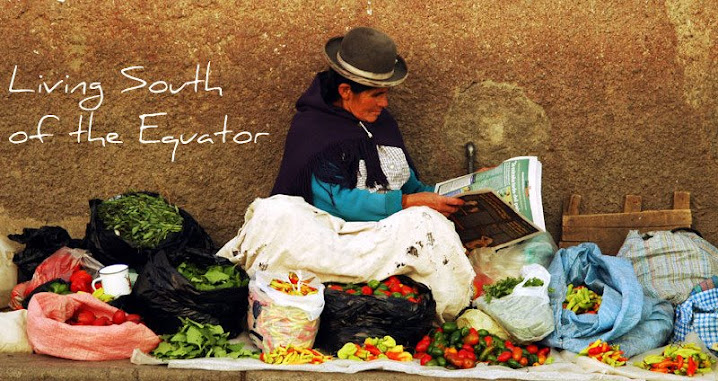 On the first Friday of each month, it is a popular tradition in Bolivia to have a k'oa. A k'oa is a ritual offering to the Pachamama in which a “mesa” is burned over coals. The “mesa” consists of incense, decorated sugar cubes, llama fat, native herbs and various other objects, depending on what you’re asking Pachamama (Mother Earth) for. You may want to be blessed with the following things: health, fertility (or more specifically, to have a boy child!!), successful business, love, money, a job, a house, a car or motorcycle, etc. In this blended world of Spanish enforced Catholicism and indigenous faiths, many people also go to Mass as part of their first Friday.
On the first Friday of each month, it is a popular tradition in Bolivia to have a k'oa. A k'oa is a ritual offering to the Pachamama in which a “mesa” is burned over coals. The “mesa” consists of incense, decorated sugar cubes, llama fat, native herbs and various other objects, depending on what you’re asking Pachamama (Mother Earth) for. You may want to be blessed with the following things: health, fertility (or more specifically, to have a boy child!!), successful business, love, money, a job, a house, a car or motorcycle, etc. In this blended world of Spanish enforced Catholicism and indigenous faiths, many people also go to Mass as part of their first Friday.
Here is my attempt to show you my most recent experience of a first Friday.
I celebrated with my work team and my boss, Enrique, who is both Quechua and a Jesuit priest. The first picture shows the flower sellers. We seem to enjoy gorgeous flowers year-round. I like it! People buy flowers to put before the images in the chapel, either for the saint of the day or for the virgin Mary. The second picture shows the line of faithful Catholics waiting for their turn to give/offer flowers or be blessed with holy water. In the background and to the sides, you can see the crosses in the far distance on the side of the mountain or the vendors who sell all kinds of things for this festive event. (I asked why there were so many crosses on the mountainside, and my companions informed me that it was "calvario"
If you don't know what you're doing, it can seem a bit chaotic. Luckily I was surrounded by guides, so I really only had to listen and observe.
After Enrique said Mass at the chapel, he joined us under our coveted spot - a hastily assembled tarp which served as our watering hole. Did I mention that alcohol is involved? As part of the ritual, many people drink beer or chicha (chee-cha), a fermented corn beverage. (Someday I will tell you how they make chicha. It isn't pretty.) When someone hands you a cup of yummy, you first offer/toast a few drops to the Pachamama. The rest is yours.
After a round or two of beer, we decided it was time to "k'oa", and Enrique went off in search of the necessary elements. He quickly came back with coal and a work-themed 'mesa'. He explained the different objects (most likely for my benefit) in the mesa and then we all gave thanks - for work, for the friendships we've made by working at the community center, for the opportunities made available to us simply by being present for our clients, and for strength to continue to do such emotional work.  A bag of coca leaves was passed around for those who wanted to chew it or offer it on the mesa. Usually, you try to find 'perfect leaves' to offer to the Pachamama. I love this picture. I think it manages to capture the thoughtfulness of the ritual.
A bag of coca leaves was passed around for those who wanted to chew it or offer it on the mesa. Usually, you try to find 'perfect leaves' to offer to the Pachamama. I love this picture. I think it manages to capture the thoughtfulness of the ritual.
Our whole team placed the mesa on the fire. Typically, a man and a woman do this (to symbolize balance - there is a male and female proponent to most things in the Andean cosmovision). I appreciated being a part of it; for me it was very moving.  After you put the mesa on the fire, you then toast the Pachamama four times, in the directions of north-west -south-east, counterclockwise. After everyone in the group has had a chance to do the toast, or ch'allar, the party begins in earnest.
After you put the mesa on the fire, you then toast the Pachamama four times, in the directions of north-west -south-east, counterclockwise. After everyone in the group has had a chance to do the toast, or ch'allar, the party begins in earnest.
Our group drank some beer, then shared a meal, and after the meal we drank some chicha. Since the meal consisted mainly of chicharron (pig parts), I abstained from eating and was therefore feeling a bit woozy. But I rallied like the best of Wisconsinites.
All in all, it was a great day where I felt very connected to Bolivia and its peoples.
This last shot is of my coworker Grace and I. She likes to joke that it is a picture of cafe y leche - coffee and milk. Ha. 
Disclaimer: this was just one of my experiences of k'oa. I've seen in celebrated in many different ways. There are some elements of the tradition that will always be present, but the way in which the k'oa is carried out may vary.
For me, celebrating the k'oa has deepened my understanding of the rich Andean culture that is infused in the Cochabamba valley.
Tuesday, December 22, 2009
First Fridays
Posted by Lauren at 2:25 PM 1 comments
Subscribe to:
Posts (Atom)

